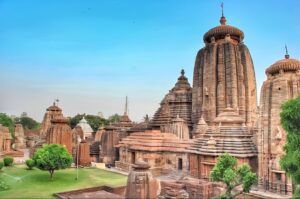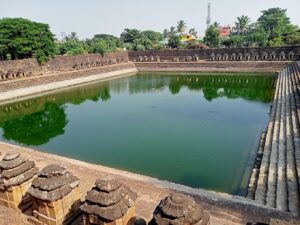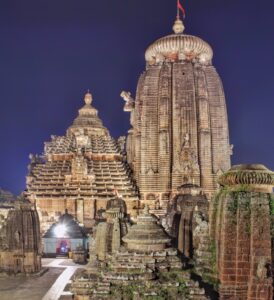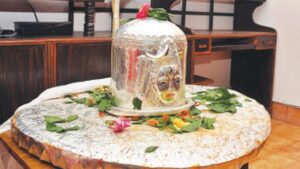Lingaraj Temple:
One of the oldest Hindu temples in Bhubaneswar, the capital of the Indian state of Odisha, is the Lingaraja Temple, which is devoted to Shiva. One of the main tourist destinations in the state and the most noticeable feature in Bhubaneswar is the temple.
The biggest temple in Bhubaneswar is the Lingaraja temple. The temple’s main tower rises to a height of 180 feet (55 metres). The temple symbolises the pinnacle of Bhubaneswar’s mediaeval architectural legacy as well as the essence of Kalinga architecture. The temple is thought to have been constructed by Somavamsi dynasty kings, with later expansions made by Ganga emperors. The temple is constructed in the Deula style and consists of four parts: the vimana (the structure housing the sanctum), the jagamohana (the assembly hall), the natamandira (the festival hall), and the bhoga-mandapa (the hall of offerings). Each part is taller than the one before it. The temple complex is surrounded by a substantial compound wall and has 108 more shrines.
Read Gujarat Temples List:
- Somnath Jyothirlingam Temple
- Shamlaji Temple
- Harsiddhi Mata Temple
- Bala Hanuman Temple
- Rukmini Devi Temple
Because the goddess Lingaraja was originally found beneath a mango tree (Ekamra), as described in the 13th-century Sanskrit work Ekamra Purana, Bhubaneswar is known as the Ekamra Kshetra. Unlike the majority of other temples in Bhubaneswar, the temple is still used for worship. The presence of Vishnu figures in the temple may have resulted from the Jagannath sect’s rise to prominence, which was fueled by the Ganga monarchs who constructed Puri’s Jagannath Temple in the 12th century. Lingaraja, the temple’s principal deity, is revered as Shiva.
Lingaraj Temple History:
The Lingaraj temple was built in the latter part of the eleventh century and is still standing today. According to certain Sanskrit literature from the seventh century, there is proof that a portion of the temple was constructed in the sixth century CE.Fergusson thinks that Lalat Indu Keshari, who ruled from 615 to 657 CE, may have been the one to establish the temple. The eleventh century saw the construction of the Assembly Hall (jagamohana), the Sanctum, and the Temple Tower; the twelfth century saw the construction of the Hall of Offering (bhoga-mandapa). Salini’s wife constructed the natamandira between 1099 and 1104 CE.The coexistence of Shiva and Vishnu worship at the Lingaraja temple, according to historians, is proof that the Jagannath (a type of Vishnu) religion had already begun to spread throughout the area by the time the temple was finished being built. Connoisseurs of Shaivism, Shaktism, and Vaishnavism, the Ganga dynasty’s rulers constructed the Jagannath Temple in Puri during the 12th century.
According to some traditions, the temple was constructed in the eleventh century CE by Yayati I, monarch of Somavanshi (1025–1040). The ancient literature Brahma Purana refers to Bhubaneswar, which Jajati Keshari moved from Jajpur to as Ekamra Kshetra. A village was gifted to the temple by one of the Somavamsi queens, and the Brahmins associated with the temple were bestowed with substantial gifts. An inscription from the Saka year 1094 (1172 CE) records Rajaraja II’s donations of gold coins to the shrine.A different 11th-century inscription by Narasimha I describes offering the ruling deity beetel leaves as tambula. The adjacent village residents were granted royal grants by Chodaganga, according to further stone inscriptions found in the temple.
According to K.C. Panigrahi, Yayti I should have started the temple’s construction, but he ran out of time. Instead, his sons Ananta and Udyota Kesari should have taken the lead. The counterargument to this notion is that such a magnificent structure could not have been built by his feeble successors.
Lingaraj temple height in feet – The complex features 150 smaller shrines in its large courtyard, and the tower is 45.11 meters (148.0 feet) high. The 55-meter (180-foot) tower is sculpted in every inch. Sandalwood is used to make the door of the entrance porch gate.
Lingaraj Temple Timings:
The timings of lingraj temple is 6.00 am – 7.00 pm
Lingaraj Temple Address:
Lingaraj temple, Lingaraj Temple Rd, Lingaraj Nagar, Old Town, Bhubaneswar, Odisha 751002
Lingaraj Temple Contact Number – 0674 2340105
lingaraj temple official website – https://www.lordlingaraj.org.in/temple.html
Festivals celebrated at Lingaraj Temple:
The primary event in Phalgun month, Shivaratri, attracts thousands of pilgrims to the temple every year. On this auspicious day, bel leaves are offered to Lingaraja in addition to a full day of fasting. The primary festivities occur at night, when devotees engage in non stop prayer. Following the lighting of the Mahadipa, a massive lamp atop the temple spire, the pious typically break their fast. This festival honours Lingaraja’s victory against a monster. Every year during the month of Shravana, thousands of bol bom pilgrims travel all the way to the temple while carrying water from the Mahanadi River.
During the 22-day Chandan Yatra (also known as the Sandalwood Ceremony), temple employees parade through the Bindusagar Tank in a specially constructed barge. Sandalwood paste is applied to temple deities and slaves as a heat-resistant coating. People connected to the temple organise dances, group feasts, and celebrations.
Ashokashtami is the day on which Lingaraja celebrates its chariot celebration, known as the Ratha-Yatra. The god is transported to the Rameshwar Deula shrine in a chariot. Thousands of worshippers pull and follow chariots that are adorned with vibrant decorations and hold the idols of Durga, Dolagovind, and Lingaraj On Dasami, Maa Parvati goes to Rameswar Deula; however, Lord Lingaraj forbade her from staying there, which infuriates Maa Parvati promises Maa Parvati to take her during the 21-day boat festival after returning to the temple.
How to reach Lingaraj Temple?
By Air: Biju Patnaik Airport, which is located in the center of Bhubaneswar, is the closest airport.
By Rail: Bhubaneswar is the closest railway station, and it is home to numerous express and superfast trains.
By Road: The National Highway No. 5, which connects Chennai and Kolkata, passes through Bhubaneswar. Moreover, visitors can take public transport or hail a cab privately.
Lingaraj Temple Distance:
lingaraj temple to jagannath temple distance – 1 hr 6 min (56.0 km) via Jagannath Sadak
Lingaraj Temple to Nandankanan distance – 44 min (20.0 km) via Nandankanan Rd
Lingaraj Temple to Konark Temple distance – 1 hr 31 min (58.5 km) via Pipli – Konark Rd
Puri to Lingaraj Temple distance – 1 hr 5 min (53.7 km) via NH316
Bhubaneswar to Lingaraj Temple distance – 22 min (9.1 km) via Bidyut Marg
Baramunda to Lingaraj Temple distance – 22 min (7.7 km) via Ekamra Rd
Lingaraj Temple to Udayagiri distance – 19 hr 24 min (1,054.4 km) via Chennai – Kolkata Hwy and NH16
Lingaraj Temple to Mukteshwar Temple distance – 6 min (1.9 km) via Jagannath Sadak/Lewis Rd/Puri Rd
Bhubaneswar Railway Station to Lingaraj Temple distance – 15 min (4.5 km) via Janpath Rd and Rath Rd





